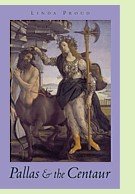|
Pallas and the Centaurby Linda ProudReviewed by Margaret Donsbach Lorenzo's conventionally pious wife Clarice actually lives a far more circumscribed life. Barred from her husband's study, from his impassioned philosophical discussions with other men, and from the decisions that lead to his excommunication, Clarice hides beneath her seemingly unruffled exterior a well of fear, grief and resentment. During the war that follows Lorenzo's disputes with the pope, she embarks on a monumental battle of wills with Angelo, deputed as reluctant tutor to Lorenzo's sons in order to nurture them to absorb the rediscovered philosophies of the ancients as he teaches them Greek and Latin. The name "Savonarola" does not appear—that is for the third novel in the trilogy—but at one level Pallas can be read as an extended foreshadowing of the violent orgy of religious fundamentalism that would explode in reaction to the blossoming of Florentine culture under Lorenzo. Other novels set during Savonarola's time present the monk and his followers as inexplicably crazed fanatics. The truth, as usual, is more complex, and while Proud is Lorenzo's partisan, she has sympathy and insight to spare for all sides. Pallas and the Centaur is best read after A Tabernacle for the Sun so the full depth of the characters' griefs, passions and joys can be appreciated. (2004, 491 pages, including a historical note separating fact from fiction) Pallas and the Centaur is on my "Best Historical Novels I Read in 2009" list. #1: A Tabernacle for the Sun. Review #3: The Rebirth of Venus.
Women, Family, and Ritual in Renaissance Italy by Christiane Klapisch-Zuber (1985). More info Inside the Renaissance House by Elizabeth Currie (2006). More info
The Stanze of Angelo Poliziano translated by David Quint (1979). More info A Translation of the Orpheus of Angelo Politan and the Aminta of Torquato Tasso translated by Louis E. Lord (1931). More info Silvae translated by Charles Fantazzi (2004). More info
"Angelo Poliziano" at the University of Massachusetts website Back to Historical Novels: Renaissance
|
 Set in Lorenzo de' Medici's Florence, Pallas and the Centaur is the sequel to Linda Proud's A Tabernacle for the Sun. A wider, more complex novel than Tabernacle, which was a tale primarily of men and men's doings, Pallas opens in the voice of Maria, separated in early childhood from her brother Angelo Poliziano, a poet and protegé of Lorenzo de' Medici. This lively, intelligent young woman is a dissatisfied nun, raised in a convent and yearning for a freer life. Disaster will present her with the opportunity to learn how women live outside its walls.
Set in Lorenzo de' Medici's Florence, Pallas and the Centaur is the sequel to Linda Proud's A Tabernacle for the Sun. A wider, more complex novel than Tabernacle, which was a tale primarily of men and men's doings, Pallas opens in the voice of Maria, separated in early childhood from her brother Angelo Poliziano, a poet and protegé of Lorenzo de' Medici. This lively, intelligent young woman is a dissatisfied nun, raised in a convent and yearning for a freer life. Disaster will present her with the opportunity to learn how women live outside its walls.